03/10/2024 – I have to begin by saying, I am in no way shape or form, suggesting anything other than the use of flat and suitably round nose bullets in any firearm with a tubular magazine. I say this because those are the safety rules provided by the super knowledgeable, well tested, and combined technical resources of the industry. No, not a lick of sarcasm in that statement and I am grateful for their presence.
If that is so, Joseph, why go any further? It’s the parrots…
It has come to my attention, that whole generations of enthusiasts, have developed their entire understanding of firearms by absorbing social media cliche comments. It is not their fault, as they have no long term history to bring context to social media… truths.
As an example, I often use round nose bullets intended for the 458 Winchester Magnum, and similar .45 caliber cartridges, when assembling… stout 45-70 Government handloads. Yes, that’s right, when I handload to pressures in excess of SAMMI standards for the cartridge, and in opposition to firearm manufacturers’ cautions.
No, I am not a bold adventurer in the world of handloading. I am actually very patient. I have no problem watching the wildebeest crossing the river, until the crocodiles are satiated and sunning themselves on the river bank. Then, I make my crossing. Read, research and test before implementing.
The minute I publish this type of load data, I hear from the social media cliche parrots. A spate of factually unsupported open letters to the editor, and social media comments led by the same, that admonish me for putting the lives of others in jeopardy by using round nose, rather than flat nose bullets in a tubular magazine.
This is where history comes in…
I am not being blasé about firearm safety or, for that matter, any other type of French emotional projection. I am merely drawing on pre mid 1960s and earlier memories, times when ammunition sold for use in lever action rifles with tubular magazines utilized round nose, not flat point, bullets. The 30-30 Winchester’s habit of round nose bullet consumption began in 1895, and that is only one of scores of cartridges that were historically configured the same.
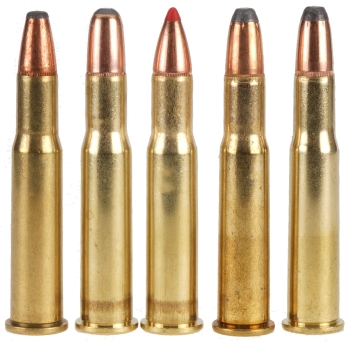
Current 30-30 WCF ammunition appears as above. L-R: 150 grain Federal Fusion, Hornady 150 grain American Whitetail, Hornady 160 grain FTX LeverEvolution, Winchester 150 grain Power Point, Winchester 170 grain Power Point. All flat point bullets, even the faux round nose Hornady Whitetail. The Hornady LeverEvolution point tip is, of course, made of deforming and reforming Flubber*
*Please see The Absent Minded Professor 1961.
What caused the change from true round nose bullets to flat nose bullets around the mid 60s? I suspect two things happened at that juncture. Firearm company liability insurance premiums spiked over unrelated incident claims, and the industry hired lawyers with no firearm knowledge to advise the industry as to what could be a potential liability.
What is going on in there?
When a trigger is pulled, the gun’s firing pin strikes the primer on the chambered round, which ignites the cartridge’s powder charge. The bullet travels down the barrel, along with gases and unburned propellant, which creates an opposite and equal force…. recoil.
Ammunition, sitting in a magazine under magazine spring loading, is not firmly anchored to the rifle, and attempts to remain where it is, even though the rifle is moving rearward under recoil. Eventually, compressed spring rate overcomes the stubborn 4 ounces of ammo, and it begins to move rearward following the rearward motion of the rifle.
The theory is that a pointed bullet, pressed against the primer of the cartridge that leads it, could cause the primer to ignite. The force exerted on the primer would be the lightest at the last and next to the last cartridge in the magazine, and heaviest at the farthest two cartridge set.
Me losing on that TV game show, Math Wars…
In the case of a 30-30 Winchester chambered, 7 lb Marlin 336, with 150 grain ammo @ 2300 fps muzzle velocity, the prior statements look like this:
The recoil velocity of the 30-30 Winchester lever action rifle
Recoil Velocity = 7.041 FPS
Impact Energy of 6 rounds of 150 grains ammunition under recoil velocity. Multi cartridge column travel is 2″, each cartridge weights 341 grains
Contact between first round bullet and second round primer is 0.0371 ft-lb, the next round 0.0742 ft-lb, the next round 0.1113 ft-lb, the next round 0.1484 ft-lb, the next round, next one 0.1855 ft-lbs. The last round into the magazine has no load on its primer.
According to the old Hatcher’s Notebook, a large rifle primer should fire with 60 inch ounces of pressure and never fire at 12 inch ounces of pressure. The ft-lb readings above, converted to inch ounces are, respectively, 7.1 inch ounces, 14.2 inch ounces, 21.4 inch ounces, 28.5 inch ounces, 35.6 inch ounces.
It would seem that four of the 5 stand a chance or being discharged under recoil in previously defined circumstance. But there are many other factors at work that lessen the energy to which cartridges in a magazine are exposed.
Much of the rearward motion, energy and velocity is lost to rotation displacement, or muzzle rise. The recoil spring never actually travels to coil bind. So while there is progressive resistance from the magazine spring against the cartridges, rather than a focused direct impact energy.
With a head full of irrelevant and misstated information… from myself, I had lunch. Two of those Walmart bulk hot dogs, microwaved, on zero carb tortillas, with chili sauce and spicy brown mustard. Serious thinking food.
Free falling 5′, a magazine would reach 18 fps by the time the nose plug hits the ground, as would its contents. The tube’s contents, with a combined weight of 4.7 ounces, would have an impact energy of 284 inch-ounces. The same mass under the rifle’s recoil velocity would have an impact energy of only 42 inch-ounces.
A length of aluminum tubing was cut to 5′, a flange was fixed to the end and the assembly was fastened onto a 2″x8″ piece of scrap wood.
The Marlin 336 magazine tube was left as is. The front was already plugged. An open cross slot, intended to accommodate the forward barrel band screw, provided a natural pressure vent.
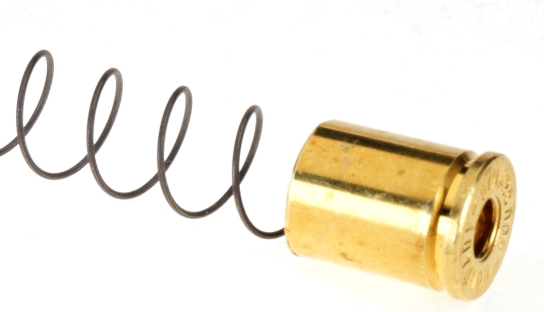
After losing the plastic factory follower to a spring unloading incident, I finally discovered a useful purpose for 500 S&W brass. The case fit the magazine tube ID, so one was trimmed down to factory magazine follower length. Worked like a champ.

I needed a stout plug for the feed end of the magazine. So I cut 4″ off of a scrap 30-06 Springfield barrel, chucked it in the lathe, and turned the end to magazine ID. The tube and plug were cross drilled to accept a short retaining pin. The bore made for a natural top vent.
While the weight of the plug did not increase free fall velocity, it did increase the shock of impact energy on the contents of the magazine. Which I realized had no impact on the suspended contents of the magazine… unless magazine spring reached a coil bound state… which it did not.
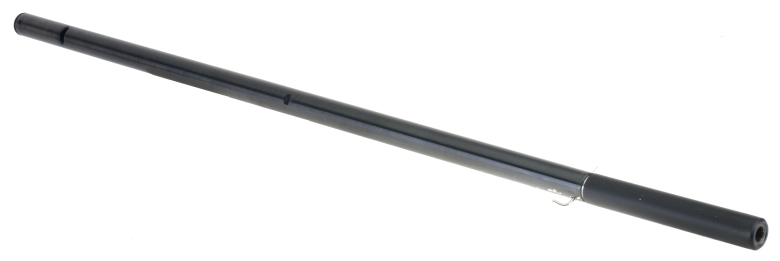
The assembly ready to be dropped down the 5′ aluminum tube; magazine tube and end plug, with feed end plug and retaining pin in place.
Working with welder’s gloves, welder’s helmet and welder’s apron…
Left to right, the leading live primer case was vented. Following in turn, each of the test bullet mounted in dead primer cases. All bullets received a hit with a Lee Factory Crimp die. Left to right: Hornady 130 grain soft point, Sierra 150 grain flat point, Hornady 165 grain soft point, Berger 168 grain VLD, Hornady 200 grain ELD X. With the exception of the primed case, stainless steel tumbling pins were added to each as needed to make them each a uniform 341 grains.
 Four dummy cartridges… excuse me, I meant performance challenged cartridges were assembled with 200 grain Speer bullets and each was also brought to a uniform 341 grains. So the assembled test magazine tube contained 1 vented primed case, 1 of the test bullet configurations, followed by 4 dummy rounds to simulate a full magazine.
Four dummy cartridges… excuse me, I meant performance challenged cartridges were assembled with 200 grain Speer bullets and each was also brought to a uniform 341 grains. So the assembled test magazine tube contained 1 vented primed case, 1 of the test bullet configurations, followed by 4 dummy rounds to simulate a full magazine.
One word defining the results, “Quiet”.
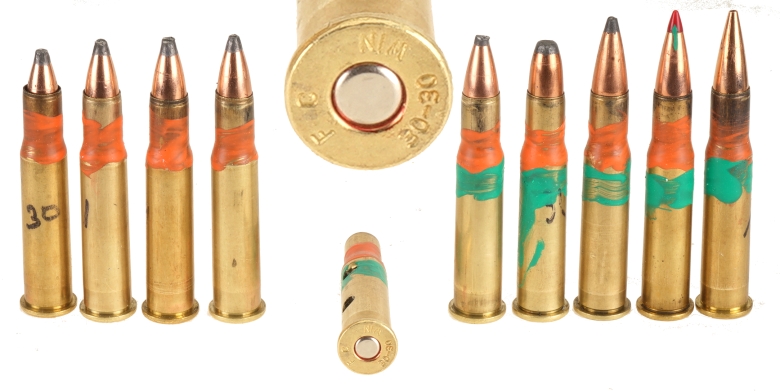
Each bullet shape of the 5 on the right were dropped 5 times. Either the bullet’s nose was deformed or there was no change. The dummy cartridges that were loaded to fill the magazine tube to 6 rounds, were smacked so hard from the fall that some jumped the Lee Factory crimp and had to be full length resized and reseated and crimped.
The sole survivor was the primer, which remained in perfect condition. Not even the pointy, protected tip Berger left the slightest indentation. That test cartridges was chambered in the rifle and it discharged normally, even in its Swiss cheese state.
My point…s? Tubular magazine rifles are not fragile and operating at the edge of magazine safety. Flat nose bullet are great, but round nose is as acceptable. Hard nose, pointed bullets, outside of controlled tests, are never acceptable in tubular magazines.
What is this were a 45-70 Gov’t Model 1895 with high pressure loads? Recoil velocity would increase to 16 fps. The magazine content would increase to 5.5 ounces and impact energy would decrease to 269 inch-ounces the 30-30 Winchester magazine experienced. A practical test for another time.

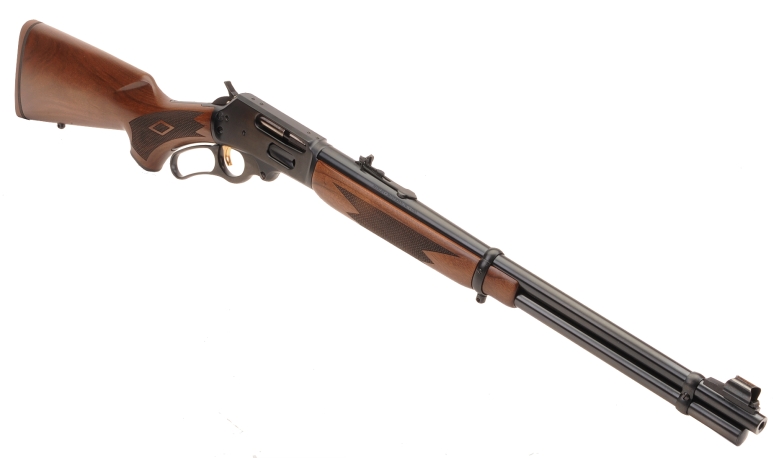

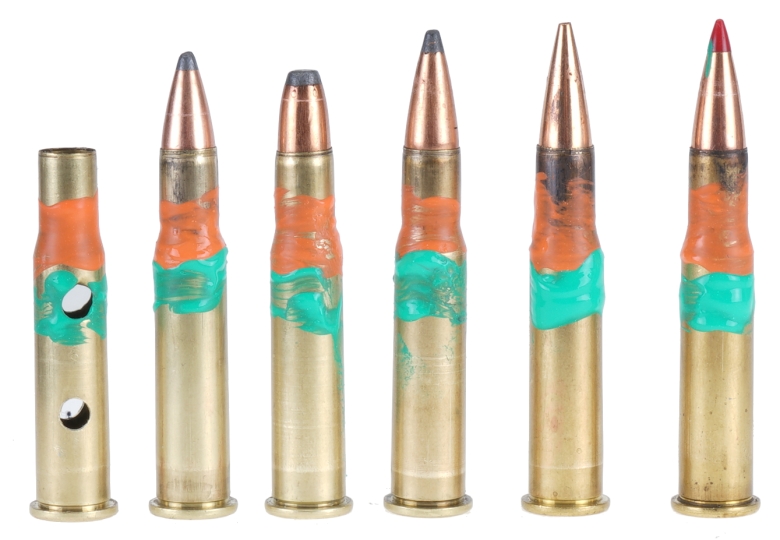
Thanks for the test . I’ve always taken that (RN) “crap” w/ a grain of salt. After all , ALL Remington 30-30 ammo was RN and the 150 gr was a rather pointy one. That’s what Dad used most of the time. Otherwise spitzer bullets worked fine , single loaded of course .
Joe, a very through and accurate test. In the real world, a shooter, hunter, or handloader wanting a spitzer bullet need look no further that the Hornady FTX in either factory loads or handloads. Another solution is to load spitzer bullets and use the rifle a a 2 shooter, one in the chamber and one in the magazine. The most range limiting factor on most 30-30’s is the use of iron sights. My 2 cents worth. Bob!
Very interesting and you made your point.